Red-tailed Hawk Nesting photos by Larry Jordan
This Red-tailed Hawk has been nesting on these high votage power lines for at least three years now. I have watched them raise three chicks to fledge each of the last two years and they are well on their way this year.
I thought I would use this as an opportunity to see the difference in digiscoping these birds at different magnifications with my Kowa 883 Prominar spotting scope. The photo above was shot at 20x magnification at a shutter speed of 1/640 of a second. All the images were shot at ISO 1000, using the Nikon D90 with an AF Nikkor 50mm 1:1.8D lens with the shutter speed compensating for the difference in magnification.
This tower is, to my best measurement using Google Earth, about 100 yards from the road where I took the photos. Here’s what it looks like using my Kodak Easy Share V1253 point ‘n shoot.
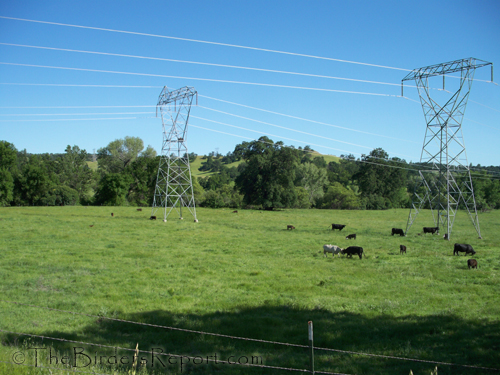
You can just see the nest on the right hand side of the tower on the left, at the towers narrowest point.
Obviously the lower the magnification, the better the image, so I try to digiscope most shots at 20x magnification if at all possible. The next three images were shot at 40x magnification but I think the quality is still pretty good. The shutter speed at this setting was 1/200 of a second at ISO 1000. None of the images have been cropped.
You can see the chicks are still covered with down but their feathers are growing out rapidly.
You can see the little tail feathers sticking up on the chick on the left side. Click on images to see full size.
At maximum magnification of the Kowa 88mm 20-60x zoom eyepiece, you get images like the two below. Not quite as sharp but I think they’e pretty good being a football field away from the subject.
These were shot at ISO 1000 and a shutter speed of 1/125 of a second.
I will be posting a page with my digiscoping set up information soon. In the meantime, get on over to Bird Photography Weekly for some great bird photos!


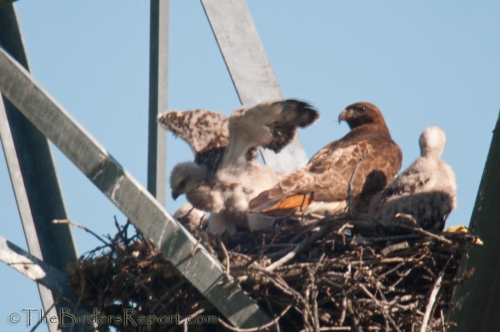
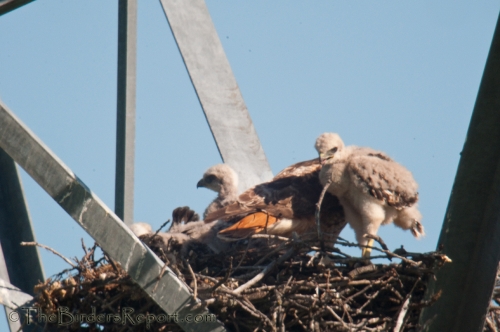

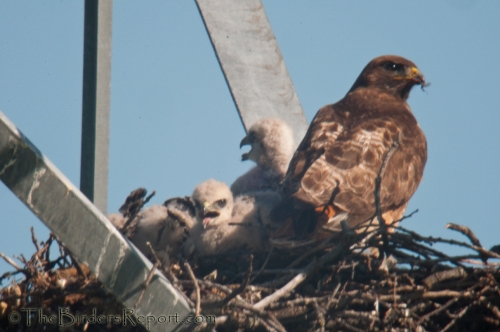
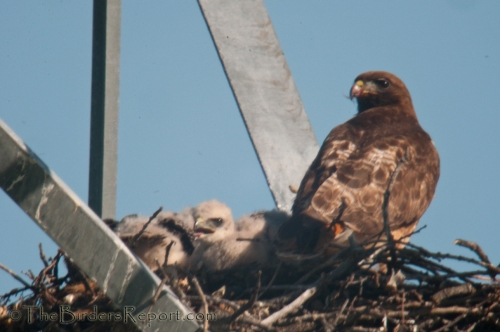








Comments on this entry are closed.
Very interesting to see the photos taken at different magnifications. You obviously have a great set-up and have solved the problem of long distance photos – which many of us would love to do also!
.-= Mick´s last blog ..Bayside =-.
Fabulous documentation Larry.
Wow, that was some magnification, Larry! Your digiscoping really is a big help in documenting the nesting of the Red-tailed Hawk.
.-= Bob K´s last blog ..Knees and No Few =-.
Those photos are amazing.
@Mick I am still experimenting with digiscoping and trying to learn the most important aspects of this technique. It sure is nice to be able to get good images in some cases without having to get so close to the subject.
@Thomas thank you for stopping by with a comment. I do find the scope an excellent resource for documenting nesting birds and their young.
@Bob it is amazing to me how much you can see with a good scope!
@Faye thanks. I appreciate your constant support and encouragement 🙂
Larry, looks like you’re getting the hang of that digiscoping thing already. It’ll be fun to see how your results come along.
What a great treat to be able to see the young hawks with parents – all in their nest. Home Sweet Home. 🙂
.-= Amber Coakley´s last blog ..Book Review: Eating Animals =-.
Holy canoly, this really shows how close you can get. Amazing!
And to be able to see them little ones without them all noticing you. Well done!
.-= NicoleB, Egypt´s last blog ..Always remember, things could be worse! =-.
@Amber thank you. I feel really fortunate to be able to watch as these beautiful raptors raise their brood
@Nicole it is amazing how close you can get with digiscoping but I must tell you, the female Red Tail checked me out every time I stopped on the side of the road to check on her progress
great job with the digiscoping. I did buy some equipment for my Canon camera and my tube. But I don´t get it to work. How many shots did you take to get those? The camera is not stable (?) on the tube and it has a lot of trouble getting the settings right. :((((
.-= NatureFooostep Fåglar/Birds´s last blog ..Silkeshäger – Egretta garzetta – Little Egret =-.
@NF the setup I use has a digital camera adapter that screws onto the scope, over the eyepiece, and a digital camera adapter ring that screws onto the camera lens, where a lens filter would go. This makes it a tight fitting solid unit.
The camera lens is set on infinity and the focus is done manually with the scope. I use the “sport” setting on the Nikon which, with the 50mm lens, gives me a wide open aperture of 2.0.
I hope this helps. I am working on a page showing the entire digiscoping set-up and discuss the settings I use.
I am hoping to get some discussion going with some of the digiscopers out there that may give us all some tips!
Great shots. Digiscoping is a totally new field for me. I’ll look forward for your page about it.
The candid shots are great. “Look, Mom! I’m a hawk!”
.-= Joy K.´s last blog ..Well, gall-eeee!! =-.
Looking forward to more of your digiscoping experiments, Larry.
It’s great to get shots like these without disturbing the birds.
.-= gwendolen´s last blog ..Satara sunset =-.
Great set of photos. Birds of prey seem to make such good parents.
.-= Joan´s last blog ..Butterfly: Eastern Comma (Polygonia comma) =-.
Funny little fuzzy-heads. Amazing to see how far away you actually were with those close-up shots.
.-= Out walking the dog´s last blog ..Faces of Morningside Heights =-.